ISSN ONLINE(2278-8875) PRINT (2320-3765)
ISSN ONLINE(2278-8875) PRINT (2320-3765)
Muthamizhan T1 and Ramesh R2
|
| Related article at Pubmed, Scholar Google |
Visit for more related articles at International Journal of Advanced Research in Electrical, Electronics and Instrumentation Engineering
The paper presents a low-cost, phase-current reconstruction algorithm for direct torque control threephase induction motor using the information obtained from only one shunt resistor which is in series with low side switches in a conventional three-phase inverter. The aim is to develop a low-cost high- performance induction motor drive. It uses the dc current to reconstruct the stator currents needed to estimate the motor flux and the electromagnetic torque. Photovoltaic arrays convert solar energy to dc electric power; uses chopper and dc-ac inverter to fed three phase Induction Motor. The chopper used here is current fed full bridge boost dc-dc converter, which is preferred and extensively used in high voltage applications and advantageous over voltage fed converters. The inverter switches are controlled by PWM techniques obtained from SVM-DTC of IM. Simulation results are given to prove the ability of the proposed scheme of reproducing the performances of a SVM- DTC IM drive.
Keywords |
| Photovoltaic systems, Zero current switching, Induction motors, Space vector pulse width modulation, Direct torque control |
INTRODUCTION |
| The induction motor stands dominant in both industrial and domestic applications.The aim is to develop a low-cost high-performance Space Vector Modulated – Direct Torque Controlled (SVM-DTC) Induction Motor drive as shown in Fig. 1. A low-cost and simple phase-current reconstruction algorithm for three-phase IM under DTC uses dc-link current, dc-link voltage and the voltages applied to the inverters switches of the conventional three-phase inverter. The shunt resistor in series with low side switches are used to draw the dc-link current of a three-phase inverter, the cost of which is less compared to a hall sensor to measure the stator current. The proposed algorithm is robust and very simple and uses the dc-link current to reconstruct the stator currents needed to estimate the motor flux and the electromagnetic torque. The photovoltaic (PV) energy is the most abundant, which is capable of providing the energy needs and having the advantage of photovoltaic pump-storage system. In this system, the use of large banks of batteries is avoided, which are expensive and have one-fifth of the lifetime of a PV panel. The PV characteristics and the issue of maximum power point tracking (MPPT) applied to the induction motor control have been addressed in different ways in the literature [1] - [5]. The fixed frequency phase-shift control enables the implementation of ZCS for all converter switches. Currentfed zero-voltage transition PWM converter use auxiliary network and hence all the power switches are zero-voltage switched or zero-current switched [6], [7]. The space vector pulse width modulation (SVPWM) method and direct torque control techniques for variable frequency drive applications have superior performance characteristics, it has been finding widespread application in recent years [8] - [12]. Sensor less space vector pulse width modulated direct torque controlled induction motor drive utilizing modified stator flux estimation logic has been proposed in literature [13] - [15]. |
| A typical configuration of a batteryless photovoltaic pumping system comprises the following components: photovoltaic panels, MPPT system, current fed full-bridge boost dc-dc converter, dc-ac inverter, three phase induction motor with a closed loop controller. The aim of MPPT is to normalize the real output voltage of PV panel to the voltage at Maximum Power Point. Hence the MPPT adjusts the output power of solar panel. If the PV output voltage is higher than MPP voltage, then transferred power to the load or network is increased, otherwise, it is decreased.Current fed converters are preferred and extensively used in high voltage applications since it is advantageous than the voltage fed converters. A very high turns–ratio transformer is used to achieve a high output voltage in high voltage applications. The SVM-DTC scheme of an induction motor under varying dynamic conditions, is used to adjust the bandwidth of the torque hysteresis controller to reduce the torque and flux ripples and hence, to improve motor dynamic response. |
PHOTOVOLTAICS |
| The conversion of solar energy into electricity using solar cells system is the valuable way of producing the alternative energy. One of the most promising applications of photovoltaic energy is pumping. However, the absence of batteries does not compromise the efficiency of the power conversion chain. Fig. 2 shows the equivalent circuit of the solar cell.The V-I characteristic of a single-junction P-N under illumination can be written as follows: |
 |
| Where the net current is the difference of photocurrent and diode current, V is the voltage, T is the absolute temperature and RS is the series resistance inside each cell in connection between the cells. The shunt resistance Rsh is neglected. A single shunt diode was used with the diode quality factor set to achieve the best curve match. |
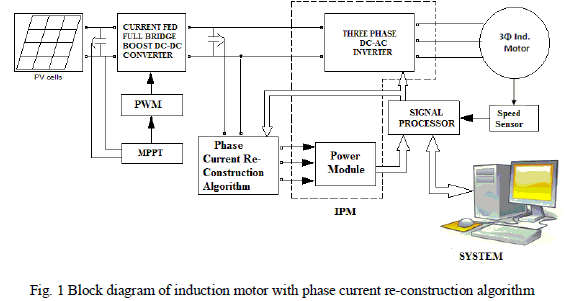 |
| Solar cells are usually connected in series, in the modules, creating an additive voltage and in parallel to yield higher amperage. Modules are then interconnected, in series and parallel to create the desired peak dc voltage and current. |
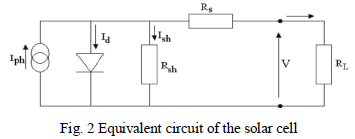 |
| The “Hill Climbing” MPPT algorithm perturbs the voltage in one direction and evaluates the corresponding difference (sign) of the power. If the power is increasing, the algorithm will move the voltage in the same direction; otherwise, it will reverse the direction. The “Hill Climbing” algorithm can be confused, and track the MPP in the wrong direction, in case of rapidly changing atmospheric conditions, when the change in PV power caused by change in irradiance is larger than the change in PV power as a function of the perturbation. The “Hill Climbing” will not be confused, if and only if |
| |ΔPu| >|ΔPg| (2) |
| where ΔPu is the change in power as function of change in voltage, and ΔPg is the change in power as function of change in irradiance. The hill climbing MPPT is optimized in respect with the sampling interval (Ta) and minimum step size (ΔVd) in order to follow a certain irradiance ramp (dg/dt). The approach is based on a second-order Taylor approximation of the PV model including resistive parts. Fig. 3 shows the V-I characteristics of the 1 kW solar array and Fig. 4 shows the P-V characteristics of the 1 kW solar array. If operating point of load is on the left of MPP, in other words if the module works as a current source, the error signal can be written as |
 |
| It is proved that the “Hill Climbing” algorithm is the one of the best method to extract the maximum power and hence this paper uses hill climbing algorithm to extract the maximum power. |
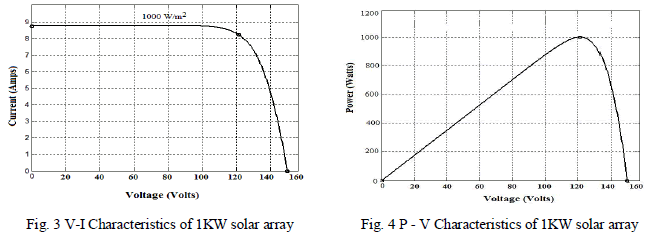 |
CURRENT FED FULL-BRIDGE BOOST DC-DC CONVERTER |
| Current fed converters shown in Fig.5, are preferred and extensively used in high voltage applications since it is advantageous than the voltage fed converters. A very high turns–ratio transformer is used to achieve a high output voltage in high voltage applications. The disadvantage of using large turns ratio transformer is the parasitic components (parasitic capacitance and leakage inductance) generate high voltage and current spikes, results in switching losses in the power devices, which has been overcome by Zero Current Switching (ZCS) operation. Constant on-time control methodology is utilized to achieve ZCS and a variable frequency control scheme is used to regulate the output voltage.In order to decrease the volume and weight of the dc-dc converter, higher switching frequency is chosen. Increasing switching frequency leads to increased switching losses which in turns reduces converters efficiency. Soft switching techniques are used in PWM dc-dc converters to reduce switching losses and Electro Magnetic Interference (EMI). Soft-switching of the dc-dc converter have either turn-on or turn-off switching losses in a power switches are eliminated. Soft switching in current fed full-bridge boost dc-dc converter has been achieved by Zero current Switching (ZCS)technique in high frequency applications using IGBT switches in the dc-dc converter. |
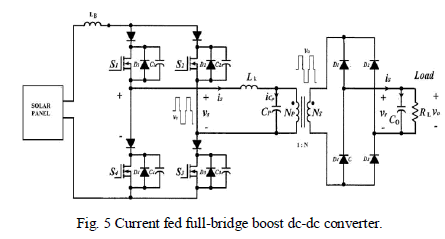 |
| The dc-dc converter utilizes the leakage inductance and the parasitic capacitance of the high-voltage transformer in order to achieve the ZCS operation. The switch can be implemented by an IGBT in series with a reverse blocking diode, an IGBT with reverse–voltage blocking capability. The current and voltage during the turning on and off of the switch is shown in Fig. 6 and the power loss of the switching component is 0.3W to 1W by ZCS.The current fed full bridge boost dc-dc converter yields an output voltage of 600 V while the solar panel input voltage is (120-180)V, the current is continuous and the converter driven near resonance.The switching pattern applied to the switches of the full bridge, utilizing the leakage inductance and the parasitic capacitance of the high-frequency transformer to achieve the ZCS operation across the switches. Fig. 7 shows the voltages at the input and output side of the high frequency transformer of turns ratio 1:4.The transformer output is connected to the diode bridge rectifier and the ripple is filtered with a bulk capacitor of value 2200 μF. The output voltage, current and power of the dc-dc converter is plotted in the Fig. 8. |
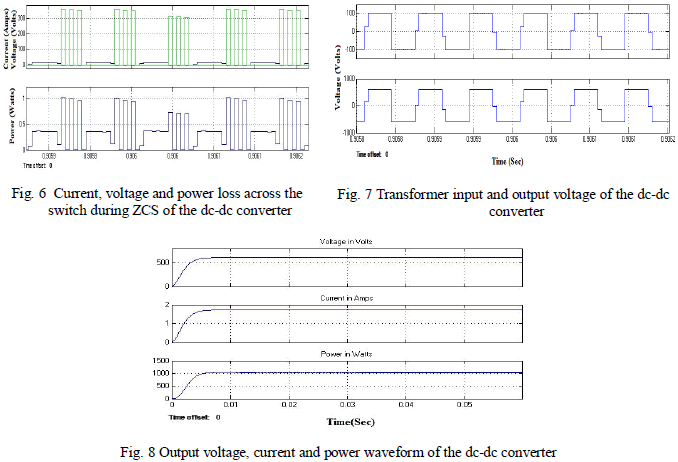 |
SVM - DTC OF INDUCTION MOTOR |
| The phase currents are estimated by the dc-link current measurement processes. The phase voltages and currents required in the classical direct torque controller is reconstructed using the dc-link voltage and dc-link current, instead of the stator phase voltages sensed from induction motor using hall sensors.The stator flux vector and the electromagnetic torque are directly calculated from the voltage and the current derived from a single dc-link voltage sensor from a voltage divider network and a single dc-link current sensor by using a shunt resistor.This algorithm does not require additional computation burden or other motor parameter knowledge. The simulation of the low cost direct torque controlled induction motor is done using MATLAB/SIMULINK simulation software. The solar panel output is fed to current fed full bridge boost dc-dc converter. The dc output voltage is filtered with a bulk capacitor and the dc voltage is given as input to the three phase inverter connected to the three phase induction motor. Here PI controller is used to tune the speed error which is used to generate the torque reference signal. |
| Classical controllers with limitations have been used to control induction machines in achieving desired dynamic response. One modification of the basic DTC is used for estimating the three-phase currents from a single dc-link current sensor. On the modification, the need of an additional current sensor requirement is minimized. The six voltage vector is applied at each cycle period, for prefixed time intervals for the Space Vector Modulation (SVM) technique. |
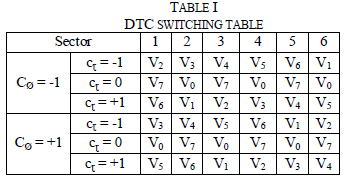 |
| By using this modulation strategy, the voltage vectors are synthesized with respect to those used in the basic DTC technique from −30âÃâæ to 30âÃâæ. The DTC switching table is tabulated in Table I. The PWMgenerated by the space vector pulse width modulation techniques for the classical DTC is as shown in the Fig. 9. The output voltage for various switching patterns can be obtained by considering an example of Space voltage V6 (state 101); the output voltages Van, Vbn and Vcn are obtained by the equivalent circuit as shown in Fig. 10.The phase voltages and currents are reconstructed using the dc-link voltage, dc-link current and the voltages applied to the switches. The phase voltages and phase currents of the stator of three phase inductor motor are reconstructed and the simulated waveforms are given in the Fig.11. |
 |
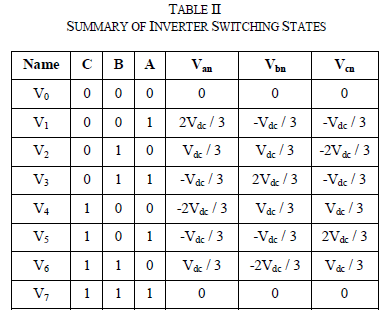 |
 |
| where Vdc is the dc link voltage. Similarly we can calculate the values of Van, Vbn and Vcn for the other five nonzero states. V0 and V1 are the zero states of the space voltage. The inverter switching states is tabulated in Table II and the parameters of the induction motor are tabulated in Table III. |
 |
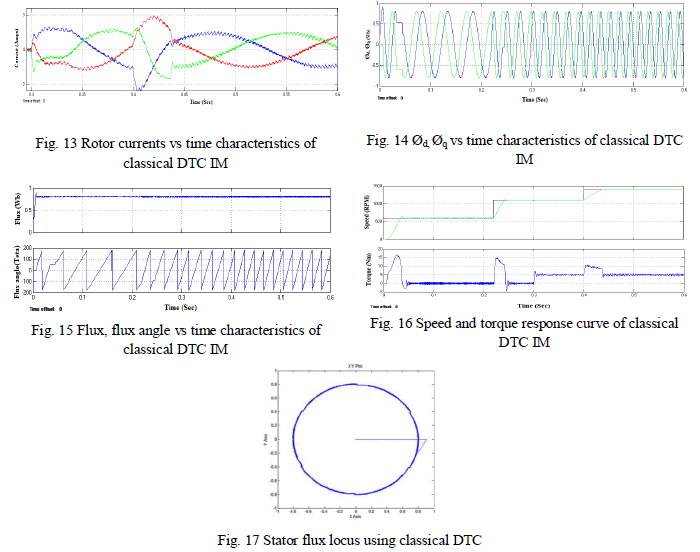 |
| Fig.12 and Fig.13 shows the stator and rotor current measured in the classical direct torque controlled induction motor respectively using MATLAB/SIMULINK software.Fig. 14 measures the direct and quadrature axis component of the flux, Ød and Øq, and Fig. 17 shows the Stator flux locus of the space vector modulated classical DTC IM.Fig. 15 shows the measured total flux Ø, flux angle θ and Fig. 16 shows the speed characteristics of the classical DTC IM using SVM |
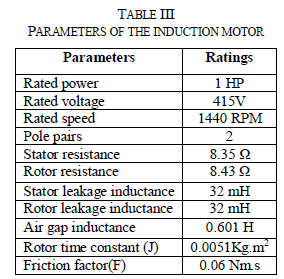 |
| The speed of the induction motor is set at 600 RPM, 1100RPM and 1400 RPM respectively at 0s, 0.22s and 0.4s. At 600 RPM, the motor speed reaches in 0.065s but settles down 600 RPM at 0.075s. At 0.22s when the reference speed is set to 1100 RPM the motor speed starts to follows the speed from 1100 RPM in 0.026s with a little overshoot. At 0.4s the speed is set to 1400RPM and the motor speed follows reach the set speed at 0.465s.Fig. 16 also shows the electromagnetic torque Vs time curve, where the torque settles down at 5 Nm finally with a ripple of 2 Nm but the transient response of the electromagnetic torque curve has more ripple. Direct torque control technique are used by many researchers because of it finds extensive applications with various ac machine types such as induction motor, PMSM, PM Brushless, and Reluctance motor. |
CONCLUSION |
| A low-cost, phase-current reconstruction algorithm for a PV powered space vector modulated- direct torque controlled three-phase induction motor was proposed in this paper. The number of sensor in the induction motor drive is reduced by using phase-current reconstruction algorithm. The maximum dc power can be obtained from the PV array by utilizing the “HILL CLIMBING” algorithm. The advantage of using current fed full bridge boost dc-dc converter here is that all of the parasitic capacitances and inductances are included in the resonant or filter circuits and the system does not generate parasitic oscillations and the output is without any uncontrolled high voltage and current spikes.The conclusion is that the whole performance of the system is improved compared to a vector control of induction motor. The settling time of the speed and ripples present in the torque are reduced hence DTC method are preferred than vector control |
References |
|